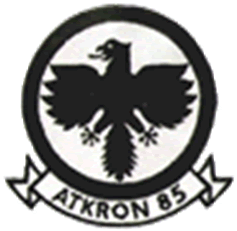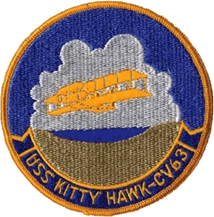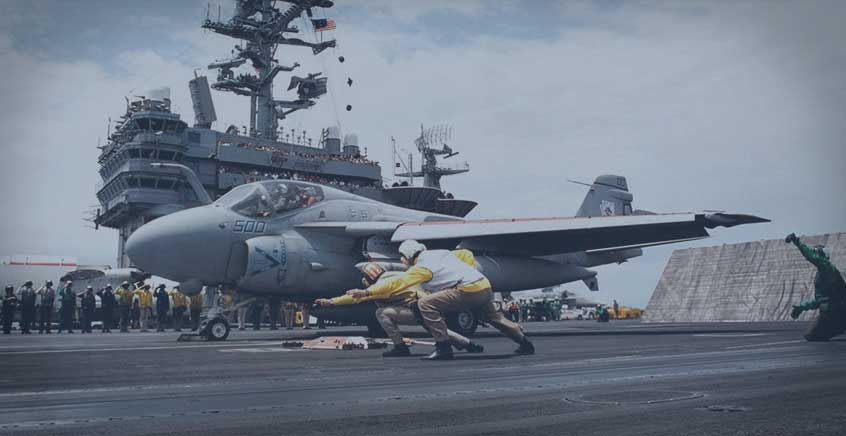A6 IN ACTION / VIETNAM | VA-85 USS Kitty Hawk 1967

It was the spring of 1967. Ho Chi Minh’s Pride and Joy, the Thai Nguyen Steel plant, had always been on the US forbidden target list and had never been touched by a bomb. Located 35 miles northwest of Hanoi, the steel plant was the centerpiece of North Vietnamese Industrialization Program. The plant was an ideal strategic target - it was the only plant in the whole country capable of producing steel for railroads and bridges.
Since the KITTY HAWK had been on Yankee Station for a while, we knew the steel plant was in the area assigned to the Air Force, so we never thought we would have to worry about it. We had heard that there were lots of high-level discussions (CINCPAC and above) going on about the possibility of removing the steel plant from the forbidden target list, but those discussions were way too political for those who salute, take cat shots, and carry out their duties as directed. Since the steel plant was so far inland, we were quite surprised when we learned that our A-6s were volunteered to participate when the plant was declared a Must-Hit JCS target.
Even before the new high-level discussions about attacking the plant started
taking shape, the plant and its associated railroad complex were already well defended by AAA, and also, it was close enough to
Hanoi for mutual SAM protection. When the Air Force was directed to bomb the railroad yards, but not the steel plant as yet,
the NVN predictably added even more SAM sites and guns to defend the steel plant.
When the Air Force eventually sent fighter-bomber formations against the steel plant, the cloud cover was too extensive to
dive bomb the target with any accuracy. The Air Force lost many aircraft in this repetitive effort because the strike group
was required to fly all the way to the target to check conditions before aborting. Thus the Air Force aircrews had to fly through
some of the strongest air defenses in the world before diverting to alternate targets. That the Air Force could continue this effort in
the face of fierce opposition and daily losses is a credit to the professionalism of their Tactical Air flyers.

However, the Navy A-6s added another dimension to the mission because A-6s were designed for night and bad weather attacks … when they worked. Our first concern was A-6 reliability. To have any chance of success and survival, you needed a good working weapons system. On a mission of this difficulty that meant that at least the main video display, computer, inertial navigation system, search radar and radar altimeter plus the normal A-6 flight and engine systems had to function properly. If the Doppler radar and track radar worked, that was a bonus. Also the Electronic Countermeasures (ECM) and the chaff dispensers had to be operating to survive in the Surface-to-Air Missile (SAM) environment. If the weapon system didn’t work you had to abort because you couldn’t find, much less hit, the target using visual means alone.
The NVN air defenses were quite formidable, and were growing by the day as our planning continued. This, coupled with our aircraft reliability uncertainties, increased our concerns as our strike planning continued. We knew that the area surrounding the steel plant was defended by SA-2 SAMs, many radar-directed 85 and 100 mm guns, plenty of 37 and 57 mm automatic flak cannon, and a whole host of smaller automatic weapons.
Then of course there was the issue of aircraft speed vs payload weight. Evading the defenses required high speeds, but at the same time, making a dent in the robust and large steel plant required lots of heavy ordnance. High speed and heavy bomb loads don’t go together that well, especially in the hot and humid Southeast Asia climate. The best A-6 bomb load for the mission was 13 Mk 83 1000 pounders mounted on five triple ejector racks. This maximized the both the number of bombs and the weight of bombs carried on each aircraft, while retaining a 500+ knot potential if the engines were trimmed well. But it meant a max capacity catapult shot at 56,000 pounds at night into the spring monsoon.
At 0030 on 24 April 1967, we completed our final briefings, and left the ready room. When we reached the flight deck, KITTY HAWK was already turning into the wind. It was a strange sensation to note that only our strike package was operating; everyone else aboard was asleep. After the usual greasy slide across the deck and stack gas inhalation, we climbed into our cockpits and strapped ourselves in.
Three tankers and eight A-6 aircraft were launched into the dark, wet night, and began heading northward toward our refueling rendezvous. A straight route from the carrier to the target could have been completed without refueling, but it required a 200 nautical mile trip overland through the defenses. The more roundabout north and then west route cut the overland distance in half, but increased total distance and fuel usage. Unfortunately our late night tanking would also alert the NVN that something unusual in the air war was about to occur.
Five minutes out, one aircraft reported a weapon systems failure and turned back. When we reached the tankers over the water due east of the target, six planes successfully linked up and refueled. One A-6 was unable to accept fuel and returned to the carrier. Six A-6s turned to the west. During the practice attacks, just before going “Feet Dry,” two more aircraft reported weapon system problems, and set a course to home.
The four remaining aircraft split up onto their assigned individual tracks and turned inland at 200 feet above ground level. Two proceeded over the offshore Karst Islands, then into the mountains to the northeast of the steel plant; the other two headed directly across the low-lying delta area south of Hai Phong and southeast of the target.
Once overland, my heart rate increased as I realized that our original eight aircraft were now reduced to four. The more targets the enemy had to deal with, the better were our chances of evading their defenses. Besides the SAM installations, there were estimated to be over 4,000 flak guns in the delta area, with highest concentrations around Hanoi, Hai Phong, and Thai Nguyen. Due to the rugged terrain, there were fewer guns in the mountainous areas, but I was inbound over the delta, heading just north of Hanoi.
I knew it was unreasonable to expect all eight A-6s to reach the target, but I had hoped for six, just to spread the defenses and to increase our chances of getting through to the target. Having only four was a real concern - the only good part about that was that it reduced the chances of mid-air collisions among ourselves, with half the aircraft racing northwest through the delta and the other half going southwest through the mountains. All aircraft would try to egress through the mountains to avoid the now alerted defenses. Our flight path coordination would be made by each crew broadcasting their arrival at each planned turn point. Each crew had all attack routes marked on its chart, so a quick estimate of potential collisions could be made.
The 200-foot run-in altitude should keep our A-6s below the effective level of the NVN’s FANSONG SAM radars and reduce tracking time for FIRECAN AAA radars. The high speed also shortened the tracking time for manually-aimed weapons. These tactics usually reduced the NVN to firing at engine sounds that left a trail of tracers arcing behind the aircraft but no damage. Only when the AAA was fired forward of the aircraft was the probability of damage high. The efficiency of the gunners could be checked by watching the tracer paths over the nose and in the cockpit rear-view mirrors.Judicious low level zigzagging helped avoid the heaviest flak.
The low level run-in would be followed by a rapid pop-up maneuver to 1200-1500 feet, about ten miles from the target. This was needed to avoid damage from your own bombs. At 1500 feet and 540 knots the bombs would release about 1.5 miles before the target. After release the aircraft would be pulled into a 4-5G turn followed by a rapid descent back to 200 feet to escape the bomb blasts … if everything went right.
At fifteen minutes to target, one of the planes in the delta lost its computer system from the jolting ride and aborted. At thirteen minutes to target, one of the aircraft in the mountains had a similar failure and turned back.
There were now two planes, their jet engines roaring, racing each other to their common target. At nine minutes to target, the A-6 in the mountains suffered a radar failure. The crew was now blind while snaking through the mountains at night. At the last second, the crew jettisoned their bombs and bounced off some trees. That A-6 turned back, with green and brown scrapes on the wing.
One plane thundered onward into the blackness …………. Alone.
The weather over the North was poor, low clouds, drizzle and some fog … good for an A-6, so very little antiaircraft fire was seen until reaching the Hanoi area. There the gunners were awake and using their ammo stockpiles to put up a barrier around the city. Quickly the remaining A-6’s track turned north of the city to avoid some of the defenses and try to use the sides of the great Thud Ridge north of Hanoi as protection. But to get near the ridge the aircraft had to climb to 500 feet to clear some smaller hills.
As the plane passed through 300 feet the intermittent sounds from the AAA FIRECAN radars became a constant buzzing. Then the deeper sounds of SAM FANSONG radar could be heard on the ECM equipment. Approaching 500 feet the FANSONG radar moved to high pulse repetition frequency (PRF) and the telltale rattle of a lock-on was heard in the cockpit. This was followed rapidly by the loud shrill tones of the APR-27 missile-warning receiver. Nicknamed the “warbler,” the APR-27 sounded just like a European police car, and the sound increased when the SAM site guidance signal was aimed at your aircraft.
The adrenalin flow in the cockpit was already high from being so far inside North Vietnam, but the rapid DEEDLE-DEEDLE of the warbler pushed the heart rate level up to a “double-pumper” – where both chambers of the heart are pumping at the same time to provide maximum blood flow to the brain. With increased oxygen in the brain, time seemed to slow down just as the night sky lit with the bright flares from SAM launches.
Instead of the normal three-shot salvos, two SAM batteries each fired all six of their launchers. One SAM went ballistic, but eleven SAMs were about to intercept my life.
The normal defensive move with a SAM was to maneuver to place the SAM at your 1 o’clock or 11 o’clock position for good visibility, and when the SAM was about 300 yards out go into a 4-5G barrel roll and dive out under the SAM. The small control surfaces of the SAM usually couldn’t turn the SAM enough for a hit. That worked for the number #1 SAM, and usually for the #2 as well, if you had the speed and altitude. But #3 was often the killer. Eleven SAMs at 500 feet was an impossible task unless you can somehow break the FANSONG’s lock-on. Technically, that meant jettisoning our bombs, radical maneuvers, max ECM, and chaff. Mentally, that meant keen observation and good judgment. Morally, prayers were definitely pouring out of that cockpit. Then there was luck, lots of good luck, and we kept our bombs.
To this day I cannot describe all the gyrations used to avoid the SAMs. I do know that somehow we never reached 1000 feet above ground level. I also know that we ended up about 15 miles off our pre-planned track. I distinctly remember seeing the ground light up in slow motion by the flash from an exploding SAM’s 300-pound warhead. I also have no recollection of pulling any Gs but only high-G maneuvering avoided the SAMs. That’s what a double-pump of blood flow will do for your senses.
I do believe that the low altitude combined with the ECM’s magic reduced the FANSONG’s accuracy so that we could generate a miss with radical maneuvers. At low level the SAMs had to dive toward the aircraft to make a hit, and any kind of miss distance meant the SAM couldn’t pull up so the SAM hit the ground or detonated in passing. All the A-6 received from the ordeal was some holes here and there, plus shrapnel stuck in the engine bay armor.
As my heart slowed back down, the A-6 provided another surprise. Despite all the wild whifferdills, the weapon system was still locked on the steel plant! Even though the aircraft was now well out in the flat delta, away from the protection of the mountains and Thud Ridge, the system was still working and the attack could continue. The SAM sites would have to reload before they became a threat again. Even the ECM was quiet. Following the system’s steering toward the target, I put the A-6 into Attack Mode. Now we were committed to the bombing run as we started a zoom climb to a 1500-foot release altitude. Then the horizon lit up from left to right. I had just enough time to think, “What the hell is that?” when AAA detonated all around the aircraft.
My first reaction was disbelief followed by an instant and intense rage. We had just survived eleven SAMs and now the !@#$%&* NVN were trying to shoot us down with old-fashioned guns. I started shouting: “You dirty *&%#, you couldn’t hit me with missiles and now you are going to try guns, too!!! I’ll destroy your whole @#$%&* steel plant, you *&%#.”
Directly forward through the intensive flak we flew until the familiar shudder of 1000-pound bombs releasing broke the spell. A “Bombs Away” call was followed by 4+Gs of a right break toward the nearest mountains and relative safety.
The initial return toward the coast seemed almost anti-climatic. The route through the mountains was basically empty of guns, and the peaks could hide our position from SAMs and MiGs. My breath became closer to normal as nothing big seemed to have fallen off the aircraft, and no warning lights were lit. The engine power seemed a little low, but the J52-P6 has always been hard to trim to 100% and correct TGT in high humidity. (TGT is Tailpipe Gas Temperature, better thought of as exhaust temperature.)
Then the Air Force did its part to make our night complete. The Big Eye surveillance plane broadcast to the world at large: “Border Violation RED 60 miles north of BULLSEYE (Hanoi).” So now everyone knows that an A-6 is sneaking through the restricted zone near China, and where we are. A quick change of course and lower altitude hid the plane from our friends, but the violation reports continued for some time.
Finally the northern Karst Islands slid under the aircraft, and the A-6 was truly “Feet Wet.” A sigh of relief, turn the oxygen off, and now it’s Marlboro time. We were totally drained after crossing back over the water, but then the black hole at the end of the boat was still waiting for us to screw up if we let our guard down now. Really all that’s left is the hard part - another night trap in the goo. A two wire was okay that night.
Epilogue:
Bomb damage assessment showed we did hit the plant that night, mostly in the Number One Furnace area, and enough damage was done so that the furnace was out of action. Over the week following this strike, more Navy A-6s and Air Force fighter/bombers completely demolished the steel plant. By then I was in Cubi Point to pick up a repaired A-6 and get special early R&R.
Courtesy of Tom Murphy

